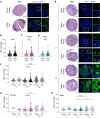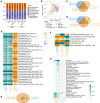Age-related dysregulation of intestinal epithelium fucosylation is linked to an increased risk of colon cancer
- PMID: 38456503
- PMCID: PMC10972600
- DOI: 10.1172/jci.insight.167676
Age-related dysregulation of intestinal epithelium fucosylation is linked to an increased risk of colon cancer
Abstract
Colon cancer affects people of all ages. However, its frequency, as well as the related morbidity and mortality, are high among older adults. The complex physiological changes in the aging gut substantially limit the development of cancer therapies. Here, we identify a potentially unique intestinal microenvironment that is linked with an increased risk of colon cancer in older adults. Our findings show that aging markedly influenced persistent fucosylation of the apical surfaces of intestinal epithelial cells, which resulted in a favorable environment for tumor growth. Furthermore, our findings shed light on the importance of the host-commensal interaction, which facilitates the dysregulation of fucosylation and promotes tumor growth as people get older. We analyzed colonic microbial populations at the species level to find changes associated with aging that could contribute to the development of colon cancer. Analysis of single-cell RNA-sequencing data from previous publications identified distinct epithelial cell subtypes involved in dysregulated fucosylation in older adults. Overall, our study provides compelling evidence that excessive fucosylation is associated with the development of colon cancer, that age-related changes increase vulnerability to colon cancer, and that a dysbiosis in microbial diversity and metabolic changes in the homeostasis of older mice dysregulate fucosylation levels with age.
Keywords: Aging; Cellular senescence; Colorectal cancer; Drug therapy; Microbiology.
Conflict of interest statement
Figures







Similar articles
-
Prescription of Controlled Substances: Benefits and Risks.2025 Jul 6. In: StatPearls [Internet]. Treasure Island (FL): StatPearls Publishing; 2025 Jan–. 2025 Jul 6. In: StatPearls [Internet]. Treasure Island (FL): StatPearls Publishing; 2025 Jan–. PMID: 30726003 Free Books & Documents.
-
Nivolumab for adults with Hodgkin's lymphoma (a rapid review using the software RobotReviewer).Cochrane Database Syst Rev. 2018 Jul 12;7(7):CD012556. doi: 10.1002/14651858.CD012556.pub2. Cochrane Database Syst Rev. 2018. PMID: 30001476 Free PMC article.
-
Interventions for promoting habitual exercise in people living with and beyond cancer.Cochrane Database Syst Rev. 2018 Sep 19;9(9):CD010192. doi: 10.1002/14651858.CD010192.pub3. Cochrane Database Syst Rev. 2018. PMID: 30229557 Free PMC article.
-
Direct-acting antivirals for chronic hepatitis C.Cochrane Database Syst Rev. 2017 Sep 18;9(9):CD012143. doi: 10.1002/14651858.CD012143.pub3. Cochrane Database Syst Rev. 2017. PMID: 28922704 Free PMC article.
-
Interplay between tumor mutation burden and the tumor microenvironment predicts the prognosis of pan-cancer anti-PD-1/PD-L1 therapy.Front Immunol. 2025 Jul 24;16:1557461. doi: 10.3389/fimmu.2025.1557461. eCollection 2025. Front Immunol. 2025. PMID: 40777041 Free PMC article.
Cited by
-
The association between 4-HPR-mediated LCN2 suppression and reduced intestinal cell senescence in ulcerative colitis.Clin Exp Med. 2025 Aug 21;25(1):297. doi: 10.1007/s10238-025-01843-4. Clin Exp Med. 2025. PMID: 40839227 Free PMC article.
-
Mitochondrial Oxidative Stress Regulates FOXP3+ T-Cell Activity and CD4-Mediated Inflammation in Older Adults with Frailty.Int J Mol Sci. 2024 Jun 5;25(11):6235. doi: 10.3390/ijms25116235. Int J Mol Sci. 2024. PMID: 38892421 Free PMC article.
References
Publication types
MeSH terms
Grants and funding
LinkOut - more resources
Full Text Sources

